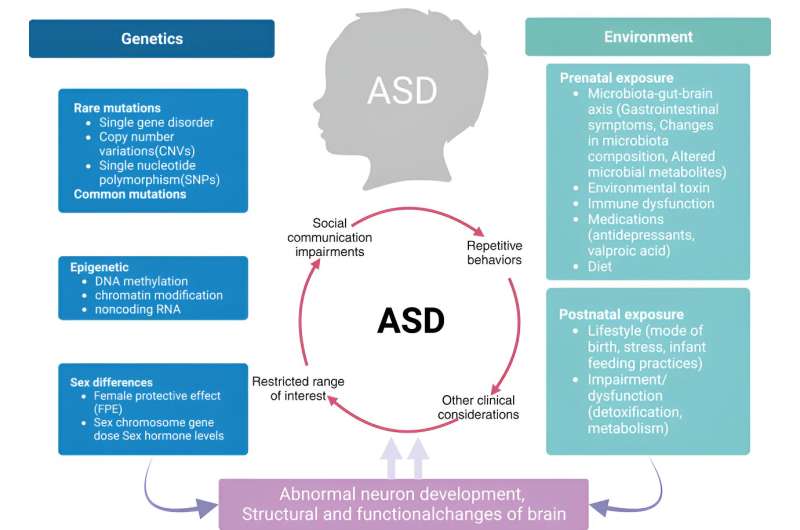This article has been reviewed according to Science X's editorial process and policies. Editors have highlighted the following attributes while ensuring the content's credibility:
fact-checked
proofread
Autism spectrum disorder: Pathogenesis, biomarker, and intervention therapy

Autism spectrum disorder (ASD) is a group of neurodevelopmental disorders characterized by early abnormal social communication and restricted repetitive behaviors and interests. The prevalence of ASD continues to rise and has attracted widespread social attention.
Heterogeneity in etiology, phenotype, and prognosis are important features of ASD, and genetic heterogeneity serves as the most critical factor in heterogeneity. Currently, more than 100 ASD risk genes have been identified.
However, no single gene or mutation can cause more than 1% of cases. The existence of heterogeneity poses a challenge to basic research and clinical translation of ASD. Recently, Prof. Liming Shen from the College of Life Science and Oceanography, Shenzhen University, and his team members reviewed the heterogeneity, pathogenesis, biomarker, and intervention methods of ASD.
They focused on the convergent mechanisms of ASD, including the common mechanisms between ASD and its co-morbidities. Studies on ASD risk genes and multi-omics reveal that synaptic dysfunction plays a key role in the development of ASD.
The mechanisms associated with important physiological and metabolic abnormalities, such as inflammation, immunity, oxidative stress, and mitochondrial dysfunction, as well as gut microbial disorders in ASD, are also of interest and deserve attention, at least appearing in some subgroups. The study of ASD from different genetic backgrounds can help to find common mechanisms between them.
Timely diagnosis plays a crucial role in facilitating early intervention and prognostic outcomes. Although specific diagnostic markers for ASD have not yet been obtained, studies including high-throughput omics have shown convergence of mechanisms associated with them, usually focusing on a few categories. Therefore, there remains optimism regarding the identification of specific diagnostic biomarkers.
The goal of ASD treatment is to improve the individual's functioning and well-being. This review focuses on approaches that are evidence-based and have positive outcomes, including behavioral intervention, educational intervention, interventions derived from technical devices, as well as medical intervention.
Currently, there is still a lack of drugs to treat the core symptoms of ASD. The authors provide an overview of existing pharmacologic therapies for ASD as well as those that target its common pathophysiology and gut microbiota.
The research is published in the journal MedComm.
More information: Hongbin Zhuang et al, Autism spectrum disorder: pathogenesis, biomarker, and intervention therapy, MedComm (2024). DOI: 10.1002/mco2.497





















